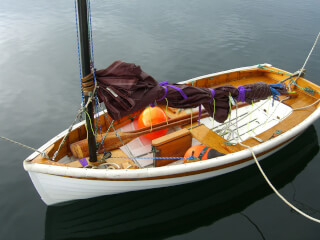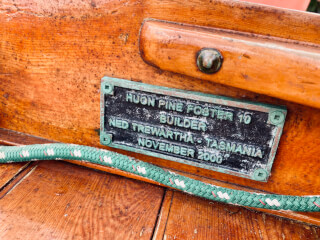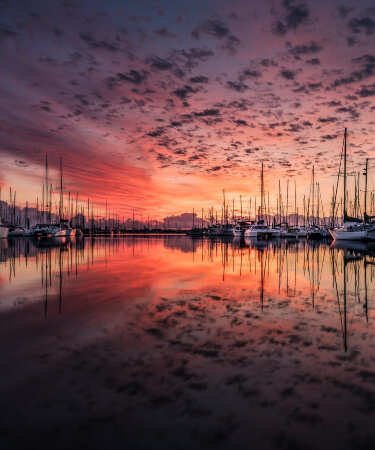Table of Contents
Typical Dinghy
When the lockdown was lifted this summer, Sailing Fair Isle made their way through various anchorages in Spain. At one point, they lost their dinghy. Until a new one arrived from New Zealand (see above), they made do with making their way around a stand-up paddle board to get to and from shore. It was less than ideal, but I applaud their resourcefulness, patience and frugality.
In this video, Andrew and I remarked how light and sturdy their New Zealand dinghy appeared. Curious about it, Andrew did some more research to understand more about its features, and it got me to thinking about our Huon Pine dinghy.
As you can see, most cruisers dinghy to and from shore in rigid inflatable dinghies. They are utility boats used to haul people, gear, and provisions back and forth to their larger cruising vessel. They can also be used to explore coves, catch fish or dive in snorkel spots. Most have an outboard motor to get around. Seldom will you see one with mast and sails. Still, rarely will you see a Huon Pine dinghy with removeable carbon fiber mast and boom, such as ours below.

Our Dinghy
In March, we were discussing the terms of purchasing RJ Slocum. Things that come with the boat vs not. Andrew and I unanimously exclaimed that we loved the dinghy, and Bill added the following perspective.
When you single-hand or double-hand a 50’ sailboat, you’re not really sailing. You pick your course, set your sails then your autopilot and you go. In contrast, sailing a dinghy reconnects you with the basics of sailing and it’s a great way to get exercise.
Jan from the hippo book also remarked how special this dinghy was.
RJ Slocum’s gorgeous dinghy would happily fit in as an exhibit in the Australian Wooden Boat Festival which is held in Tasmania every 2nd February. Boats built from Huon Pine are uncommon and very expensive and are highly sought after here.
I decided to do some research to find out exactly what was Huon Pine and why was this dinghy so special.
Here’s what I found out.
Huon Pine
Huon pine is grown only in Tasmania in wet, temperate rainforests and it grows extremely slowly, 1 mm girth per year. They can grow to be 2,500 years old. Their timber has remarkable properties. Because of its high oil content (methyl eugenol), the timber is impervious to insects (marine borer and screw worm) and it’s waterproof. Working with this timber is a dream: it can be bent, shaped, worked and sculpted without splitting and finishes with a beautiful lustre from pale straw when freshly cut to rich honey gold as it ages.

Huon Pine is the prince of timbers. In the early days when these properties were discovered, it was heavily exploited. However, given their slow growth, the Tasman government had begun to conserve and manage the forests of Huon Pine in an effort to protect the future of these venerable giants. 85% of the Huon Pine forests are protected in National Parks. 15% is managed by Forestry Tasmania for salvage, who controls and surveys all salvage and harvesting.
When I shared this finding with Andrew, he was not surprised. His surprise occured back in December when everything about s/v Rachel J Slocum, including her dinghy astounded him. Perhaps I didn’t dive into the details because there was so much to take in and therefore it was a surprise to me now. Or, perhaps Andrew isn’t really fazed about this revelation, given what we know about Bill and his approach to designing and building Rachel J Slocum. It stands to reason he would take the same care in having her dinghy built.
Suffice it to say, it blew my mind!

Designer
When we were in Florida, we had a chance to launch this dinghy. With 2 people, a custom crane and roughly 30 minutes of time, we were able to hoist the dinghy off the deck and place her safely next to us in New River. There are additional spars that can keep her next to RJ Slocum, without banging against the hull.
We also found out that she was designed by Ned Trewartha, a boat builder in Australia introduced by Hugh, one of Bill’s closest friends. Seeing the photos of boats in his workshop reminds me of the episodes that Andrew and I have come to watch of Sampson Boat Co., who is rebuilding Tally Ho, a 1910 wooden gaff cutter.
Beautiful lines. Symmetry. Warm honey tones.

Storm Sailing
In a recent O’Kelly’s podcast, they were talking about the age of their life raft. This was on the heels of their youtube video on costly first-time buyer mistakes (we made). Turns out when they bought their catamaran, the seller did a swapadeedoo, and the life raft they got was not the same as the one that they thought they bought.
They also mentioned that generally one never steps “down” onto a life raft. The direction here is significant, because a life raft is deployed generally when the boat is sinking. One should step “across” or “up” onto a life raft from a sinking ship.
We’ve seen some pretty hairy sailing footage of races during storm conditions and when we see sailors in a life raft at sea, it seems a fate worse than staying on a boat. Check out the footage on the following:
These events led us to believe and agree with the O’Kelly’s that if given the choice of a life raft or a dinghy, we would much rather step onto the dinghy in an emergency situation. Sailing Eurybia echoes the same sentiments when they were looking for their choice of a perfect dinghy, a Portland Pudgy that is also outfitted as a lifeboat. If we were to take that notion once step further, wouldn’t it be better if you had a sailing dinghy that wasn’t reliant on an outboard? One may be able to sail across significant passages compared to a motor dinghy.
Finally, a common adage among prepared cruisers is the preference of having spares. Knowing all this, I feel pretty safe having a spare sailing vessel.
Thanks for reading!
Share Huon Pine Dinghy with your friends:
Stay up to date with our content releases, by subscribing to our RSS Feed or follow us on Facebook and Instagram.
 If you would like to delve deeper into our adventure as it unfolds, please consider joining the Serenade Wind Crew. Our sister site provides more information on what it means to be part of the crew, unlock the pirate’s booty, and receive other exclusive access and benefits.The first 50 members have a gift waiting.
If you would like to delve deeper into our adventure as it unfolds, please consider joining the Serenade Wind Crew. Our sister site provides more information on what it means to be part of the crew, unlock the pirate’s booty, and receive other exclusive access and benefits.The first 50 members have a gift waiting. 